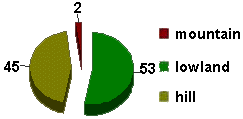 |
PUGLIA |
 Back to Italy |
| Provinces
-This region has 5 provinces: Bari, Brindisi, Foggia, Lecce, Taranto Chief town - Bari Surface - kmq 19347 National Parks- National Park of Gargano (1991)  Russian Version |
 |
|
|
||
 |
PUGLIA |
 Back to Italy |
| Provinces
-This region has 5 provinces: Bari, Brindisi, Foggia, Lecce, Taranto Chief town - Bari Surface - kmq 19347 National Parks- National Park of Gargano (1991)  Russian Version |
 |
|
|
||
 |
Origin of the Name |
| Reliefs - Passes - Coasts - Islands | |
| Landscape | |
| Agriculture - Stock-Farm - Fishing | |
| Industry - Tourism | |
| Position and Frontier | |
| Rivers - Lakes | |
| Climate | |
| Population | |
| Communication |
Origin of the name:
In the antiquity some people that populated these
earths were called Apuli, from which taken the name the zone Apulia.
Subsequently changed in Puglia. In the Roman period the arrangement augusteo
gave the name to these earths with Apulia et Calabria, because to that time
Peninsula Salentina was still denominated Calabria.
Always in Murgies the famous Caves of Castellano are
also found, while Salento (or Peninsula Salentina) has the same nature of
Murgies, but it is lower and less fertile.
The coasts are marshy in the territories of the coastal lakes of Varano and of
Lesina. Generally they are low and sandy except a brief line of the promontory
of Gargano where tall and steep are. The coastal shore is a lot of uniform.
This its linearity has interrupted from Gulf of Manfredonia where the mountains
of Gargano predominate and from the natural harbors that are that of Taranto,
Brindisi and Capo of Otranto.
Unlike the near regions, the territory of Puglia is the more omegeneos of Italy owed to the lack of the Appennineses.
Agriculture - Stock-farm -
Fishing:
The agricultural production is one of the most
remarkable in Italy. Develop are the crops of the grapevine and the ulivo that
don't require terrestrial very fertile. Puglia to the first places is set for
the production of oil, wine and table grape. Very important is the production
of oat and vegetables, that of almonds for which Calabria is second alone to
Sicily, of hard wheat in the territory of Tavoliere, of fig trees in the
proximities of Bari, of tobacco and sugar beets in Lecce. The breedings are
above all of ovini. It is tried of to also increase that some cattle that it is
very scarce. The fishing is made in the whole coast, and it is practiced above
all that of tall sea. We remember the fishing of the shellfishes and the
deriving molluscs in the greatest part from the breedings in Taranto. The
principal gardens are those of Manfredonia, Gallipoli and Monopoli.
Position and Frontier:
Puglia is also called ‘the heel of Italy '. It is
extended in the extreme southeast of the italic peninsula. It confines to north
and to east with Adriatic Sea, to south with Ionian Sea and to west with
Basilicata, Campania and Molise.
Rivers - Lakes:
The only rivers that have a remarkable importance are
Ofanto that goes down in Adriatic and Fortore that marks the configne with
Molise. Others less important are Candelaro and Carapelle.
Climate:
The climate is Mediterranean typically: dry heat in
summer and mild in winter. In the territory of Puglia the rains are very rare.
Only in winter there are some rainy precipitations. Puglia is the least rainy
region than Italy.
Population:
Puglia is a highly populated region and
extend to increase more always. The phenomenon of the emigration is
decreaseing notably, above all after the industrial development. City as
Bari and Taranto have doubled their number of inhabitants in little time. The
agricultural population has assembled in the big rural suburbs. As in the whole
southern Italy the isolated houses are very rare. Only in the zone of Murges
there are still some typical residences called trullis.
Communication:
In Puglia there are three railway lines that connect
the Region with the rest of Italy: along the adriatic coast races the line for
Ancona-Bologna, while from Bari and from Taranto those for Naples. The highways
allow of to connect Bari with Bologna and Naples with Rome. The road net allows
some good connections with all the places. The most important aeroporios are
those of Palese next to Bari and of Casale in the proximities of Brindisi.
Web Site designed by MediaSoft - © Copyright 1998-1999 - All rights reserved